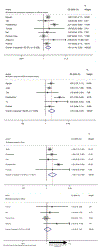Associations Between Anxiety and Adherence to Antiretroviral Medications in Low- and Middle-Income Countries: A Systematic Review and Meta-analysis
- PMID: 30659424
- PMCID: PMC6639150
- DOI: 10.1007/s10461-018-02390-8
Associations Between Anxiety and Adherence to Antiretroviral Medications in Low- and Middle-Income Countries: A Systematic Review and Meta-analysis
Abstract
Untreated mental health disorders among people living with HIV (PLHIV) may prevent low- and middle-income countries (LMICs) from achieving the UNAIDS 90-90-90 targets. Anxiety disorders may be associated with decreased adherence to antiretroviral therapy (ART). We sought to review and meta-analyze studies estimating associations between anxiety and ART adherence in LMICs. We searched PubMed, PsychINFO, CINAHL and EMBASE for relevant studies published before July 18, 2018. We defined anxiety as reported anxiety scores from screening questionnaires or having a clinical diagnosis of an anxiety disorder, and poor ART adherence as missed doses, poor visit attendance, or scores from structured adherence questionnaires. We used a random effects model to conduct a meta-analysis for calculating a pooled odds ratio, and conducted sensitivity analyses by time on ART, anxiety evaluation method, and study region. From 472 screened manuscripts, thirteen studies met our inclusion criteria. Eleven studies were included in the meta-analysis. PLHIV who reported anxiety had 59% higher odds of poor ART adherence compared with those who did not report anxiety disorder (pooled odds ratio [pOR]: 1.59, 95% confidence interval [CI] 1.29-1.96, p < 0.001). When excluding PLHIV who initiated ART within 6 months, reported anxiety remained strongly associated with poor ART adherence (pOR: 1.61, 95% CI 1.18-2.20, p = 0.003). Among PLHIV in LMICs, reported anxiety was associated with poor ART adherence. This association persisted after the ART initiation period. Increased resources for mental health may be important for achieving virologic suppression in LMICs.
Keywords: Adherence; Antiretroviral therapy; Anxiety; HIV; Low-income countries.
Conflict of interest statement
Figures
Similar articles
-
Alcohol Use and Antiretroviral Therapy Non-Adherence Among Adults Living with HIV/AIDS in Sub-Saharan Africa: A Systematic Review and Meta-Analysis.AIDS Behav. 2020 Jun;24(6):1727-1742. doi: 10.1007/s10461-019-02716-0. AIDS Behav. 2020. PMID: 31673913 Free PMC article.
-
Electronic Health Interventions to Improve Adherence to Antiretroviral Therapy in People Living With HIV: Systematic Review and Meta-Analysis.JMIR Mhealth Uhealth. 2019 Oct 16;7(10):e14404. doi: 10.2196/14404. JMIR Mhealth Uhealth. 2019. PMID: 31621641 Free PMC article.
-
Impact of mental disorders on low adherence to antiretroviral therapy in people living with HIV in Spain.Psychol Health Med. 2025 Feb;30(2):341-356. doi: 10.1080/13548506.2024.2407438. Epub 2024 Sep 29. Psychol Health Med. 2025. PMID: 39342966
-
Factors for incomplete adherence to antiretroviral therapy including drug refill and clinic visits among older adults living with human immunodeficiency virus - cross-sectional study in South Africa.Trop Med Int Health. 2018 Mar;23(3):270-278. doi: 10.1111/tmi.13026. Epub 2018 Jan 9. Trop Med Int Health. 2018. PMID: 29243867
-
Mental health and cognition in relation to adherence to antiretroviral therapy among people living with HIV in Kazakhstan: a cross-sectional study.J Int AIDS Soc. 2024 Jul;27 Suppl 3(Suppl 3):e26320. doi: 10.1002/jia2.26320. J Int AIDS Soc. 2024. PMID: 39030875 Free PMC article.
Cited by
-
Mental health, substance use and viral suppression in adolescents receiving ART at a paediatric HIV clinic in South Africa.J Int AIDS Soc. 2020 Dec;23(12):e25644. doi: 10.1002/jia2.25644. J Int AIDS Soc. 2020. PMID: 33283916 Free PMC article.
-
Cognitive interviewing of the PHQ-A for depression screening among adolescents living with and without HIV in Malawi.J Affect Disord. 2025 Jul 12;390:119863. doi: 10.1016/j.jad.2025.119863. Online ahead of print. J Affect Disord. 2025. PMID: 40652986
-
Attitudes towards and experiences with economic incentives for engagement in HIV care and treatment: Qualitative insights from a randomized trial in Kenya.PLOS Glob Public Health. 2022 Feb 23;2(2):e0000204. doi: 10.1371/journal.pgph.0000204. eCollection 2022. PLOS Glob Public Health. 2022. PMID: 36962322 Free PMC article.
-
The Impact of COVID-19 on HIV Self-Management, Affective Symptoms, and Stress in People Living with HIV in the United States.AIDS Behav. 2021 Sep;25(9):3034-3044. doi: 10.1007/s10461-021-03335-4. Epub 2021 Jun 15. AIDS Behav. 2021. PMID: 34129142 Free PMC article.
-
Contemporary prevalence and predictors of anxiety among patients living with HIV/AIDS in Ghana.Ghana Med J. 2022 Sep;56(3):169-175. doi: 10.4314/gmj.v56i3.6. Ghana Med J. 2022. PMID: 37448991 Free PMC article.
References
-
- UNAIDS. 90–90-90 An ambitious treatment target to help end the AIDS epidemic United Nations; 2014.
-
- UNAIDS. Ending Aids Progress Towards the 90–90-90 Targets. Glob Aids Updat [Internet] 2017;198 Available from: http://www.unaids.org/sites/default/files/media_asset/Global_AIDS_update...
-
- Demyttenaere K, Bruffaerts R, Posada-Villa J, Gasquet I, Kovess V, Lepine JP, et al. Prevalence, severity, and unmet need for treatment of mental disorders in the World Health Organization World Mental Health Surveys. JAMA 2004. June;291(21):2581–90. - PubMed
-
- World Health Organization. Mental Health Atlas Vol. 93, Bulletin of the World Health Organization; 2015.
-
- Nakimuli-Mpungu E, Bass JK, Alexandre P, Mills EJ, Musisi S, Ram M, et al. Depression, alcohol use and adherence to antiretroviral therapy in sub-Saharan Africa: A systematic review. AIDS Behav 2012;16(8):2101–8. - PubMed
Publication types
MeSH terms
Substances
Grants and funding
LinkOut - more resources
Full Text Sources
Other Literature Sources
Medical
Miscellaneous




